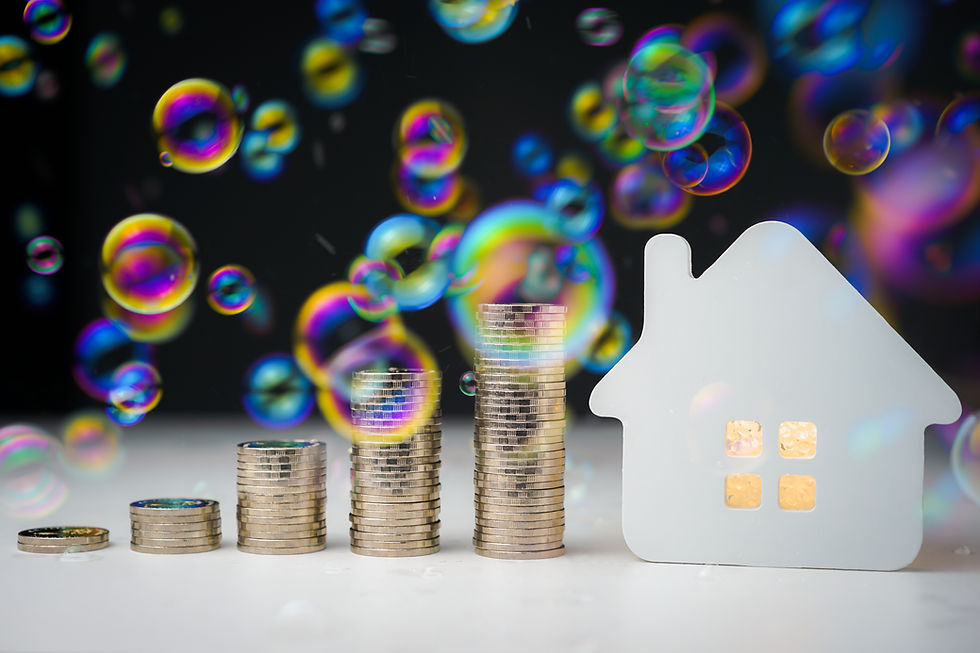THERE IS NO REAL ESTATE BUBBLE… AND HERE’S WHY - Edric Maguan
- Edric Maguan

- Jan 17, 2020
- 4 min read
Updated: Jan 21, 2020
One of the most common questions I get from my clients is “Is there a real estate bubble?” This fear of a bubble typically stems from the idea that a growth as incredible as what we’ve seen in the Philippine real estate market over the past several years is impossible to sustain. But by understanding the numbers behind the rapid growth, you'll realize that for the real estate market, there is no way to go... but UP!

First and foremost, let’s define what bubble means.
The term "bubble," in the financial context, generally refers to a situation where the price for an asset exceeds its fundamental value by a large margin. During a bubble, prices for a financial asset or asset class are highly inflated, bearing little relation to the intrinsic value of the asset (Investopedia.com).
Why the real estate market growth is not a financial bubble
Property prices are driven by three major economic indicators: (1) law of market supply and demand, (2) capacity to buy, and (3) major infrastructure developments.
1. The Law of Supply and Demand
When looking at demand and supply of our current real estate market, we have to compare the increase in demand versus the increase in supply. It is easy to see that the supply in the Philippines is increasing, but how is it relative to the increase in demand?
One easy way to determine this is by taking a look at the vacancy rate and rent prices. Even with all the residential projects that have completed over recent years, there is still a very strong demand for more, as evidenced by the 2% vacancy rate in Metro Manila and the estimated increase in rent price of 5.8% for 2019 compared to 2018.
Buyers actually using their property and renters showing their willingness to pay more rent shows there is actual demand for real estate, not merely speculative.
2. Capacity to Buy
Increasing purchasing power of the local consumers from the young labor force
The Philippines has been one of the most robust and stable economies of the past decade. Certainly, the Philippines has taken great advantage of its demographic window of opportunity, a time where the vast majority of the population is of working age. The median age of Filipinos is estimated to be around 25.7 years old, meaning a huge and productive work force by global standards fuels the country’s rapid and stable GDP growth (between 6% to 7% annually since 2012).

Increasingly high OFW remittances
Our economy is also backed by record-breaking OFW remittances, which has grown every year since 2010, back when total annual remittance amounted to $18.8B, and has ballooned to $28.9B in 2018, a Compounded Annual Growth Rate of 5%. While 2019 numbers for OFW remittances have yet to be finalized, it is projected to do even better as we are on pace to cross the $30.0B mark.
3. Major infrastructure projects
We are also in the midst of a golden age of infrastructure, with Php972.5B allotted in the approved budget for 2020 (House Bill 4228), 6.8% higher than for 2019. It promises to be even better in the coming years as Diokno, Governor of Banko Sentral ng Pilipinas, has stated that he projects that infrastructure spending will average around Php1.67T per year in 2021 and 2022.
With major projects such as the Metro Manila Subway, MRT Line 7, several international airports and various improvements of roads and bridges for Metro Manila and the country as a whole set to complete in the coming years, the future looks bright. This has also emboldened the most renowned developers of our country to make bigger and better projects all over the country, all of which will boost property value.

2020 and Beyond
The Philippine GDP is projected to continue its strong and rapid growth. Rajiv Biswas, IHS Markit Chief Economist for Asia Pacific, estimates that the GDP will double between 2018 and 2026, backed by the continuous growth of OFW remittances and a healthy diversity of Philippine and foreign businesses entering the country (BPO, POGO, tech, etc.). In addition, per capita GDP in the country is expected to exceed $4,000, pushing Philippines into the ranks of upper middle-income developing countries, according to World Bank standards.
Major infrastructure projects such as the SLEX-NLEX connector and the Metro Manila Subway, among others, will also complete in the coming years. This, supplemented by all the real estate developments of the country’s top developers, will serve to make property more valuable in the coming years.
That’s why the best time to invest in real estate was always yesterday and the second best time is today.
Start your journey with us today! I'd like to help you make the right investment decision, so I’m offering a ONE-ON-ONE CONSULTATION FOR FREE where you will get (1) property recommendation, (2) investment analysis with projected earning potential, plus (3) investment tips.
LIMITED SLOTS ONLY!
Sources: JLL Metro Manila Market Overview 2019; Colliers Philippines Q3 2019 Residential Report; worldmeters.info; Philippine Statistics Authority; Banko Sentral ng Pilipinas; IHS Markit, Week Ahead Economic Preview, 29 April 2019
ABOUT THE AUTHOR
Edric Maguan is an avid real estate investor, an experienced and accredited Real Estate Broker of several top developers, and a Certified Public Accountant from University of the Philippines - Diliman. He found his passion in inspiring and empowering people to make the most out of their hard-earned money through real estate investment. Read full biography here.



Comments